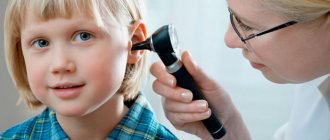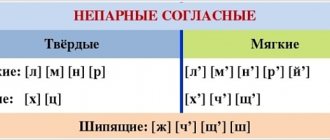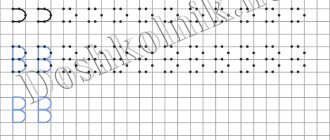Pronunciation problems
Defects
in
children, problems
associated with incorrect reproduction
of hard
“L” and soft “L” are usually divided into 2 large groups.
Presented in the table
:
| Group name | Type of deviation | Characteristic |
| Lambdacism | Nasal. | The child pronounces a sound with incorrect breathing. The air flow will enter the nasal passages. (“L” is replaced by “NG”). |
| Bilabial. | During pronunciation, the baby involuntarily makes a straw with his lips. It turns out that “L” is replaced with “U” (varnish with Uak; summer with Ueto, etc.) | |
| Interdental. | The tip of the tongue ends up in the interdental space. | |
| Absence of a letter in a conversation. | The child completely excludes the letter from the vocabulary (the lamp changes to Ampa). | |
| Paralambdacism (changes the phoneme to other sounds) | Replacing "L" with "V". Paw - Vapka; Moon - Vuna. | |
| Replacing "L" with "G". Chair – Stug; Meadow - Gug. | ||
| Replacing "L" with "D". Line - Desk; Fox - Dis. | ||
| Replacing the hard “L” with a soft one. Dala - Dalia. | ||
| Replacing “L” with “YA”, “Yo”, “YU”. Paw - Yapka; Spoon - Yozhka; Love - Yubov. | ||
Expert opinion
Margarita Sergeevna S.
Speech pathologist and speech pathologist with 15 years of experience working in various speech correction centers with children of different ages.
Any of the listed types of deviations can be eliminated with the help of speech therapy exercises and techniques.
Causes
In order to quickly form the correct
pronunciation
of a phoneme in a child, it is necessary to find out the root causes of the violations:
- bilingualism in the family;
- interdental pronunciation;
- the tongue is relaxed.
Note: Another reason for incorrect pronunciation of a sound is the age of the baby.
Children under 4 years old tend to make mistakes and confuse phonemes in words.
When such cases occur, the baby experiences incorrect placement of the speech organs. The position of the tongue is poorly designed, so the sound is distorted. There are situations when the defect is associated with breathing problems during a conversation:
- formation of phonemes with lips;
- the tip of the tongue does not touch the teeth. It just goes down and the sound is lost;
- the tip of the tongue is behind the lower teeth, and its middle is closer to the palate. When reproducing the phoneme “L” it should be the other way around.
Each of the above reasons is eliminated in individual lessons.
with a speech therapist and doing
homework .
to eliminate
deficiencies
in a short period of time, subject to regular work.
Important:
for dysarthria, it is necessary to perform complex exercises under the supervision of specialists. The presence of the disease presupposes a phased production of the phoneme “L”.
Diagnosis differentiation
Poor pronunciation of sounds is associated with various problems. Dysarthria is associated with impaired muscle movement. Children change articulation poses poorly and do not feel the movement of their tongue or lips.
Hyper- or hypotonicity is noted. The muscles are very tense or seriously weakened.
Associated symptoms are identified:
- hypersalivation (excessive salivation);
- poor chewing of food;
- problems with fine motor skills;
- weak breathing.
Dysarthria affects only sound pronunciation. The remaining components of speech are not impaired. Children have a vocabulary and formulate phrases grammatically correctly.
With dyslalia, there are disturbances in sound pronunciation. They appear due to defects in the structure of the organs of articulation, somatic weakness, with minimal brain dysfunction.
To make a conclusion, it is necessary to make sure that the child’s hearing is in good condition and that there is no disturbance in muscle tone.
Dysarthria and dyslalia are different diagnoses!
With general speech underdevelopment (GSD), all its components suffer. Children have a limited vocabulary, connect words incorrectly, and pronounce sounds poorly.
A child can pick up an incorrect sound pattern from his parents. The baby perceives the adult’s speech and tries to repeat it.
With alalia and delayed speech development, problems with sound pronunciation are observed. When correcting, much attention is paid to stimulating the appearance of speech, without attaching importance to its correctness.
Correct diagnosis guarantees competent alignment of the correction process. With dysarthria, it will take more time to automate the sound. With OHP, it is important to develop all components of speech.
A preschooler will learn to speak correctly with timely speech therapy assistance. How quickly the correction will take place depends on certain factors: diagnosis, parental involvement, number of classes.
Correct articulatory position of the speech organs
When pronouncing “L”, the speech apparatus takes the position:
- Lips half open. The position is completely neutral to pronounce the vowel phoneme after the consonant sound.
- The upper and lower teeth are slightly open.
- The tip of the tongue rests on the upper jaw (teeth or gums). The rest of the tongue is completely down.
- The lateral edges of the tongue and the far teeth form a small space between each other on both sides. An air stream passes through the slots.
The formation of the soft sound "L" is slightly different. The lips assume the same position as when smiling. The tip of the tongue focuses on the alveoli (tubercles behind the front incisors). The rest of the tongue is slightly raised.
Demonstrated in pictures
,
how to put
the sounds “L” and “L”:
Exercises for the speech apparatus
Articulation gymnastics —
the most important component of successfully overcoming
pronunciation
deficiencies Completing tasks
with an emphasis on the speech organs is
a preparatory stage
before setting the phoneme. Basic exercises for training the mobility of the lips and tongue:
- Hammock . Use the tip of your tongue to touch your upper teeth. The rest of the organ is bent downwards, forming a hammock. Stay in this position for 10-15 seconds.
-
. Move the wide tongue first along the upper, then along the lower lip. In this case, the lips should be motionless.
Delicious jam - Turkey . The tongue licks its lips at an accelerated pace. At this time, the child should try to say bl-bl-bl-bl.
Horse.
The baby is asked to imitate the clicking of an animal's hooves. The tip of the tongue flicks the roof of the mouth.- Wide smile.
The baby is asked to stretch his lips into a smile as far as possible and freeze in this position for a few seconds. The exercise will be repeated 2-3 times.
Note: classes help train articulation
if it is difficult to place any types of phonemes - voiceless or voiced , hard or soft, etc.
Breathing exercises
The sounds “L” and “L” are produced as you exhale. To correctly place the phoneme, experts recommend regularly performing inhalation-exhalation exercises:
- Stop, horse! Take a deep breath, and as you exhale say br-br-br.
- Ball.
The baby is asked to lie down on the floor. Hands are placed on the tummy. As you inhale, the “ball” (tummy) inflates, and as you exhale, it deflates. - Ship. A paper boat is lowered into a basin of water. The baby is offered to move it with a stream of air.
Breathing exercises are performed for 2-3 minutes daily.
Advice: a detailed
work plan and more detailed methods of training the speech organs are provided by a speech therapist. The specialist will explain how to quickly and effectively carry out the exercises.
Additional Impact
For dysarthria, it is advisable to use speech therapy massage. It is manual or probe. It is carried out before exercise to relieve hypertonicity or muscle activation.
Speech disorders are often associated with problems of memory, attention, and thinking. Corrective work requires the assistance of a psychologist. He conducts classes on developing skills, self-esteem, and motivation.
For problems with tone, physiotherapy is indicated. It relieves tension well or stimulates muscles. It needs to be done in courses. If necessary, the neurologist prescribes drug treatment.
Parents should prepare for a long learning process. It all depends on how interested they are in the result. Articulation and breathing exercises must be carried out at home.
In the process of automation, adults control the child’s speech, correct him, and learn simple phrases and poetry.
Methods for making the sounds L and L
What sound can you make the sound L from?
determined individually for each child, taking into account capabilities and skills. In speech therapy practice, the following methods are distinguished:
- By imitation. Performed while sitting in front of a mirror. The baby is shown the correct location of the speech organs in the reflection and asked to repeat. After a successfully completed task, they are asked to sound out the letter in this position.
Note: the lesson is most suitable for children with a complete absence of phonemes in words, when there is no need to rearrange the established positions of organs during reproduction.
- Setting from the letter “Y”. Occurs in a playful way, simulating a steamship. The baby is asked to smile broadly. Lightly bite your tongue and pronounce the sound “Y” in a drawn-out manner. It will smoothly turn into a drawn-out l-l-l. You can try this exercise with other vowel sounds.
- Setting from the letter "B". The lesson is aimed at inhibiting the lower lip. When pronouncing the letter “B”, the baby should not move his lower lip. If it doesn’t work, the adult holds the sponge with his finger. For preschoolers
, they read special
poems
or sing
songs
with an abundance of the letter “L” in the words and ask them to repeat. - Production from the sound “L”. A soft sound is pronounced more readily by a child. It does not require tongue tension and is faster. To get a solid phoneme, the baby is asked to reproduce syllables
(La, Lo, Lu). At the same time, they are asked to reach the upper lip with the tip of their tongue. - Mechanical method. Performed using a special tool or clean fingers. Carry out the manipulation only under the supervision of a speech therapist or with his participation. The tongue is asked to be lifted by the upper incisors. The instrument maintains it at the desired level during pronunciation of the phoneme. The method is suitable for patients with dysarthria.
Expert opinion
Margarita Sergeevna S.
Speech pathologist and speech pathologist with 15 years of experience working in various speech correction centers with children of different ages.
The above methods can be performed one at a time or several can be used at once. All the secrets
You can learn how to perform the techniques during a consultation with a speech therapist.
Diagnostic methods
Parents may not notice problems with their child's speech. Therefore, the examination is carried out by a speech therapist. He learns the pronunciation of all sounds. To facilitate the process, special aids are used. They contain pictures with different sound positions (at the beginning, middle and end).
The next part of the diagnosis is a speech hearing examination. Consistently, the child is asked to identify pictures for a given sound and name the first sound in the word.
They test the ability to combine objects, eliminate unnecessary ones and tell the features of using things. They study the grammatical design of speech, understanding prepositions and words with different stresses (lock - lock).
The speech therapist examines the articulatory apparatus and draws conclusions about its structure. They will check the muscle tone: if it is elevated, they will be tense, the tongue will stand in a lump in the mouth. When weakened, he is lethargic and motionless.
Based on the diagnosis, a conclusion is made and a corrective route is built.






